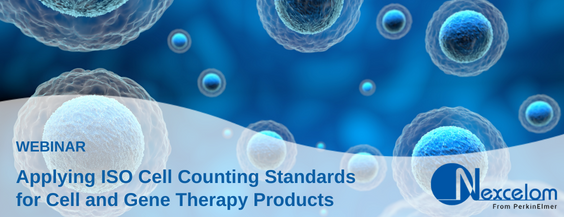Webinar on Demand: Applying ISO Cell Counting Standards for Cell and Gene Therapy Products

Speakers from NIST, SCB, and Nexcelom Bioscience breakdown and simplify the ISO Cell Counting Standards.
The rapid advancements in cell and gene therapy product development along with the expansion of industry partners and regulatory agencies, highlight the need for standards in cell counting and viability measurement assurances. Recently, ISO 20391-2:2019 Biotechnology — Cell counting – Part 2: Experimental design and statistical analysis to quantify counting method performance standards were published to guide the development of fit-for-purpose cell counting methods.
In this webinar, speakers will introduce ISO cell counting standards and how they fit into cell counting method selection and development. Additionally, we will describe the key cell counting success factors provided in ISO Cell Counting Standard Part 1 for improving the quality of cell counting results. Finally, we will describe the use of ISO Cell Counting Standard Part 2 in demonstrating experimental protocols for evaluating and comparing various cell counting methods to determine the quality of the cell counting measurement process.
Key Takeaways:
- Why companies should implement standards; specifically ISO Cell Counting Standards 20391, Parts 1 and 2
- Introduce the six key success factors to evaluate and compare different cell counting methods by establishing a multi-parameter analytical approach
- Demonstrate the fit-for-purpose analytical tools to develop and compare different cell counting methodologies
Presenters

Catherine Zander, Ph.D.
Scientific Program Manager | Standards Coordinating Body (SCB)
Dr. Catherine (Katie) Zander is a Scientific Program Manager at the Standards Coordinating Body (SCB). Prior to her role at SCB, her experience includes researching rare blood clotting disease and founding a patient education program at the University of Alabama at Birmingham, working in the U.S. House of Representatives Committee on Energy and Commerce as an American Society of Hematology & American Association for the Advancement of Science (AAAS) Science & Technology Policy Fellow and co-chairing the National Postdoctoral Association’s Advocacy Committee.
Katie holds a Ph.D. in Chemistry from Binghamton University, where she studied the kinetics and molecular mechanisms of neurotransmitters.
Dispelling Standards Myths and the Benefits of ISO Cell Counting Standards Implementation
Abstract:
The Standards Coordinating Body (SCB) is dedicated to helping speed up the process of standards development and implementation through the education, coordination, and engagement of the regenerative medicine/advanced therapies stakeholders. It is a misconception that the implementation of standards slow innovation and implementation of standards is too often misunderstood.

Sumona Sarkar, Ph.D.
Biomedical Engineer | NIST Biomaterials and Biosystems Division
Sumona Sarkar, Ph.D. is a Staff Scientist at NIST in the Biomaterials and Biosystems Division. As a biomedical engineer, Dr. Sarkar, is currently focused on the development of analytical methods for the characterization of cells and cell-based products. She serves as an expert in standards development for ISO TC 276 Biotechnology, and USP BIO5 Expert Committee on Advanced Therapies. Her research interests and expertise are in developing strategies for measurement assurance in cell counting, viability, and characterization assays as well as investigating cell-material interactions and biomaterials design. Dr. Sarkar has been at NIST for 9 years and received her PhD. in Biomedical Engineering from Drexel University, and her B.S. and M.S. in Biomedical Engineering from Boston University.
Tools and strategies for the development of fit-for-purpose cell counting methods.
Abstract:
Cell count based methods are critical for safety of cell therapy products, monitoring of manufacturing processes, and evaluating product quality. Due to the complex nature of cell-based samples, and the diversity of cell types and counting modalities, a fit-for-purpose (i.e. appropriate for the intended use) approach is necessary when developing cell count based methods. Here we present key concepts from ISO biotechnology standards that can be applied when developing fit-for-purpose cell counting based methods as well as a NIST tool that supports the implementation of the ISO 20391-2:2019 Biotechnology — Cell counting — Part 2 standard. We also share particular considerations for establishing cell counting based methods for evaluating cell viability.

Leo Chan, Ph.D.
Technology Research & Development Manager | Nexcelom Bioscience
Leo Chan, Ph.D. currently serves as the Technology R&D Manager at Nexcelom Bioscience, Lawrence, MA. For the last 10 years, he was involved in the development of instruments and applications for the Cellometer, Cellaca, and Celigo high-throughput image cytometry systems for detection and analysis of cell-based assays in the field of immuno-oncology, cell/gene therapy, regenerative medicine, protein science, and microbiology. Leo’s primary focus is on cell counting and education for image-based technologies.
Practical Application of ISO Cell Counting Standards to Improve the Quality of Cell Counting Measurements
Abstract:
Biological samples range in complexities and require various considerations, formulations, and bioprocessing steps depending on intended utilization. As there are no ground truth reference materials for live cells, determining the accuracy of cell counting becomes challenging. Therefore, to increase the confidence of cell counting results, following the ISO cell counting standards is necessary to ensure the appropriate cell counting methods are selected and evaluated.
